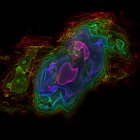“The Josephine Lawrence Hopkins Foundation Colloquium” - "What Makes a Starburst Tick?"
In the context of galaxy evolution, it is of particular interest to better understand the mechanisms that regulate star formation activity in galaxies. ALMA observed the prototypical nearby starburst galaxy NGC 253 in cycles 0-2, in the 3mm band that contains the ground rotational transitions of several key molecules. In this talk I will present an analysis of the molecular ISM properties in the nuclear starburst region derived from the ALMA data. I will show that the molecular wind is very significant at determining the duration of the starburst phase, and I will discuss the possible gas entraining mechanisms. These data also allow us to obtain for the first time a detailed view of giant molecular clouds in a starburst environment. I will show that the clouds we are able to identify have very large surface and volume densities, and consequently short free-fall and sound crossing times, which are likely connected to the large star formation efficiencies found in these environments. Finally, I will present and discuss some of the chemical complexity we see in the data. The extremely rich spectroscopy, a common feature in many ALMA datasets, opens new windows for the study of physical conditions in extragalactic systems.

